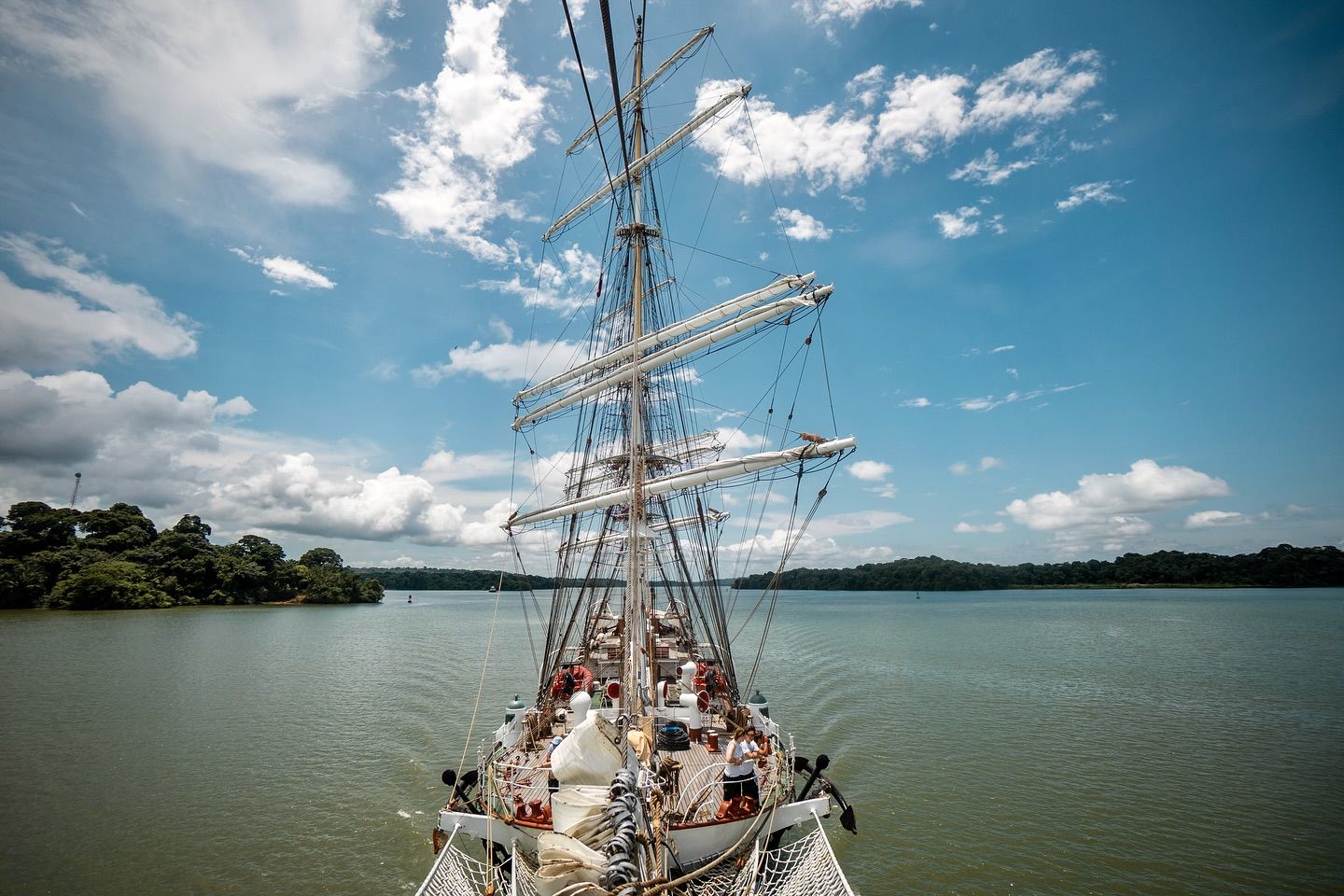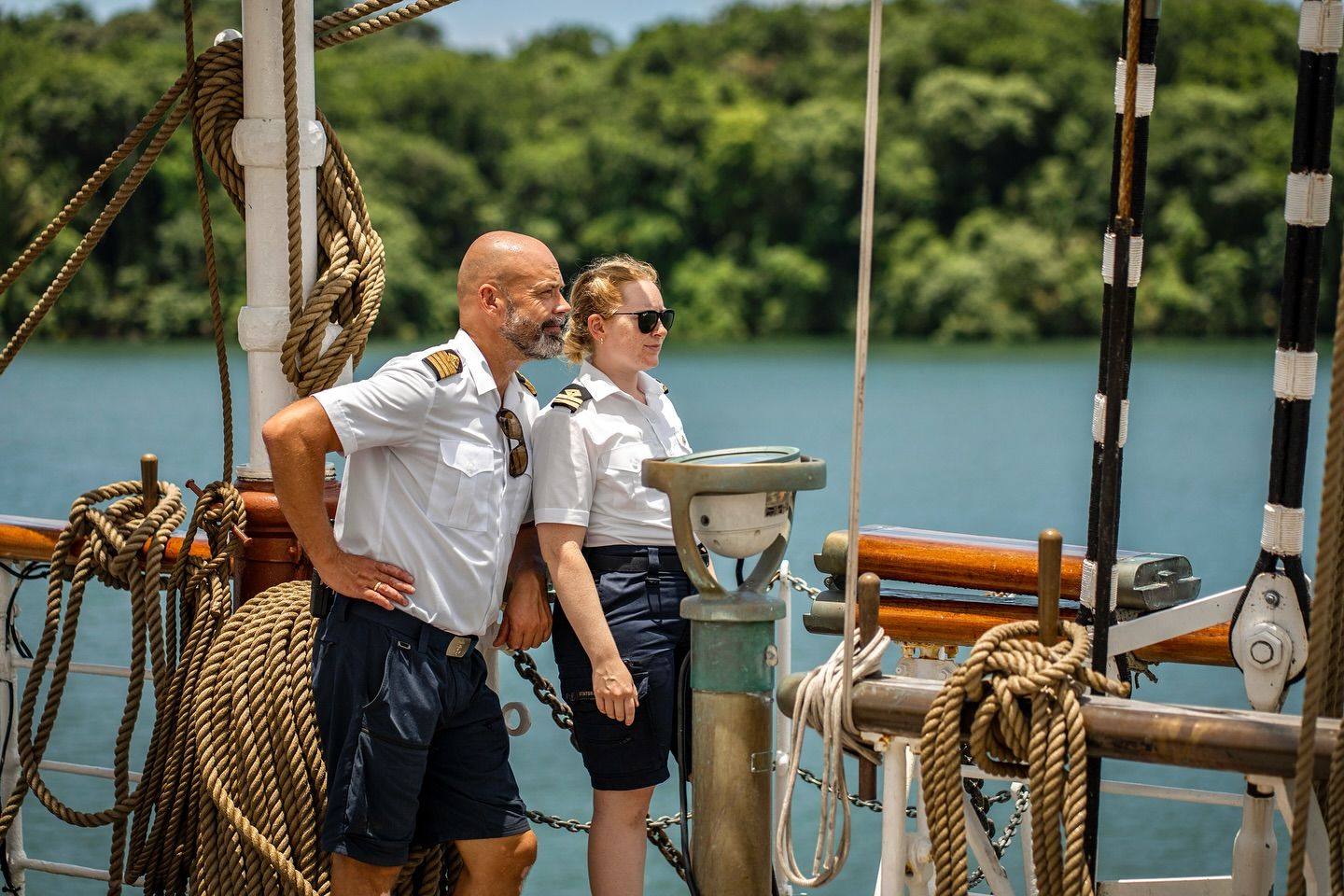The journey through the Panama Canal was a first both for Statsraad Lehmkuhl and for Captain Jens Joachim Hiorth.
The Panama Canal officially opened on August 15, 1914, seven months after Statsraad Lehmkuhl slid off the slipway and into the sea for the very first time. Since then, the vessel has sailed all seven seas, but it still took 111 years before she took the shortcut between the Atlantic and the Pacific.

– It was always the plan to go through the Panama Canal on this expedition, but we were supposed to arrive from the Pacific side and not from the Atlantic, explains Captain Jens Joachim Hiorth.
Twice over
When Statsraad Lehmkuhl set out on the One Ocean Expedition in April, the plan was to enter the Pacific via the Northwest Passage, sail south along the west coast of North and Central America, and then pass through the Panama Canal in December.
Instead, Statsraad Lehmkuhl had to enter the Pacific ocean via the Panama Canal. When we talk to Jens Joachim, he is taking the ship north along the coast to Vancouver in Canada. There the ship will turn south again and rejoin the original route. That means through the Panama Canal a second time.
– Because the passage had been on the plan all along, we had already done quite a bit of preparation. As early as November-December last year we were in touch with the canal authorities. They set quite a few requirements for vessels going through, and especially when it’s the first time, they want to make sure everything is in proper order, says Jens Joachim.

Today, ships are often built with the Panama Canal in mind, with hulls and mooring arrangements adapted to the locks. For Statsraad Lehmkuhl, there were quite a few things that did not meet the requirements of the Panama Canal administration.
– We informed them about this beforehand and received a kind of pre-approval, where they said - yes, this should work out, but you will need to undergo an inspection when you arrive, then we’ll take a closer look.
Delayed
Sailing through the Panama Canal is not something you can do by impulse.
– There are a great many ships lined up to pass through, and you have to book a slot well in advance, explains Jens Joachim.

Statsraad Lehmkuhl’s slot was scheduled for Sunday, September 14. On the morning of September 12, the ship arrived and anchored in due time. The inspection was set for September 13.
– But the hours passed, and by the end of the day we were told the inspector wouldn’t arrive until the next morning. That was right before we were to go through the canal, and perhaps not entirely ideal, says Jens Joachim.
– Normally I think it’s fine that such inspections are done quickly and efficiently, but since this was the first time it would have been nice if they had taken a little longer and gotten properly oriented on board. Still, a clear plan was made, and wherever our equipment didn’t exactly match their rules, we found solutions.

After everything was set, the canal pilot came on board, together with a group of so-called line handlers.
– The pilot had 40 years at sea and 30 years of experience from the Panama Canal, and he knew very well what he was talking about, smiles Jens Joachim.

Cargo straps
The task of the line handlers was to take in, fasten, and release the mooring lines that held the ship in place inside the locks. There are six locks, three at each end of the canal. The ships sail in and out of the locks under their own power, but once inside, four electric locomotives keep them clear of the walls - two in front and two at the stern, running on rails and tightening or slackening the lines with winches.

– Our challenge was that the locks are quite tall, eight meters, much higher than the sides of our ship. So the locomotive lines were running upward when we were at the bottom of the locks. Our fairleads, where the lines come on board, are open at the top since they are designed for berths that are lower than us. But we solved it with some cargo straps that held the lines in place so they wouldn’t jump out and damage our railings, explains Jens Joachim.

Gatun Lake
After the locks on the Atlantic side, ships sail into a large lake, Gatun Lake, which was created by damming a river when the canal was built. The dam is right next to the locks and can be opened in heavy rain to prevent water from flooding into them.
– Since we came from the Atlantic side, we sailed north to south across Gatun Lake, and then actually a little eastward again before the final three locks down to the Pacific. And then we were out, passing Panama City. That part was staged beautifully for us - since we started in the morning and came out just as the sun was setting.

An engineering marvel
Jens Joachim’s first trip through the Panama Canal remains a wonderful experience.
– I must admit I didn’t really know what I was getting into. What impressed me most was the engineering. Everything works. And the amazing thing is that it works in exactly the same way today as it did in 1914. And when it works that well, you know someone really took the trouble to think things through thoroughly before they got started. The locomotives have of course been replaced several times, but they handle the ships in exactly the same way as 100 years ago.

Jens Joachim’s gets excited.
– There are still rowboats that come out with the lines from the locomotives to the ships when you approach the first lock. Fantastic! And for some reason the locomotive operators are not allowed to talk on the radio, so when the pilot tells them to fasten, they only respond by ringing a bell. Things like that are a bit fascinating, but it works very, very well, he says.

– Otherwise, everything was very well maintained, from the lawns to the boats the line handlers came aboard with. And when the pilot came on board with a hat and dress uniform jacket, I felt almost transported - maybe not all the way back to 1914, but certainly quite a few years back. We get pilots on board in almost every port we arrive at, but this was the first time I had one come aboard in full ceremonial uniform, laughs Jens Joachim.
– Even though everything was new and exciting, I have to say the most enjoyable part for me was seeing how smoothly it all flowed. Not only that they have such a good system in the Panama Canal, but also on board. Everyone gave their all from morning to evening, doing everything they were asked to do and everything they weren’t asked to do. Everyone saw and understood what was happening and took hold of the tasks that needed to be done. I’ve never doubted that I have the world’s best crew, but this was one of those days when it became very, very clear, he says.

A small comfort
So is the Panama Canal a small comfort for you after the Northwest Passage didn’t happen?
Jens Joachim hesitates before answering.
– Everyone had really been looking forward to sailing the Northwest Passage, myself included, and had spent a tremendous amount of time planning for two and a half years. So when it didn’t happen, even though we were prepared for that possibility, it was of course very disappointing. So yes, this turned out to be a small comfort.







